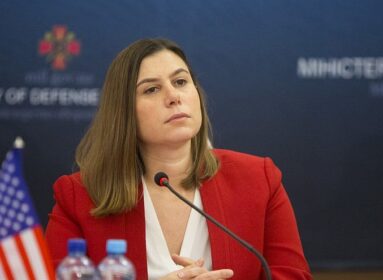By Cindy Mindell ~
Every year, thousands of teens from around the world converge on Poland and Israel for March of the Living (MOTL).
They come to Poland on Yom Hashoah (Holocaust Memorial Day) where they march from Auschwitz to Birkenau. They continue on to Israel to observe Yom Hazikaron (Israel Memorial Day) and Yom Ha’atzmaut (Israel Independence Day).
The New England region of MOTL participates every other year. This year, 56 Jewish teens from Connecticut, Newton, Mass., Providence, R.I., and Harrisburg, Pa., participated in the program. The Connecticut teens were participants in Jewish educational programs around the state, including Merkaz in Bridgeport, MAKOM in New Haven, Kulanu in Stamford, and Yachad in West Hartford.
The trip was planned and facilitated by Rich Walter, director of the March of the Living New England region, and director of the Center for Jewish Life and Learning at the Jewish Federation/JCC of Greater New Haven.
This is the seventh time Walter has organized and led the trip, beginning in 1999 while serving as director of the Bureau of Jewish Education of Rhode Island. Since 2000, the New England group has always included Holocaust survivors. This year, three survivors participated – a husband and wife from Stratford, and a New Jersey resident who joined his daughter, son-in-law, and granddaughter, who live in Wallingford.
The group was accompanied by educators Saul Fussiner of the New Haven Academy, Rabbi Suri Krieger of Westchester County, and Ruth Page, former director of the Bureau of Jewish Education of Rhode Island, as well as Waller.
West Hartford resident Amy Zablotsky decided to participate because her grandfather, a Holocaust survivor, passed away last October.
“When I realized that the link in the chain connecting my family to its past was broken, I had to find a way to fix it the best I could,” she says. “So I decided that going back to see where it happened was the best way. Reading books and seeing pictures and movies wasn’t enough for me.”
Zablotsky, 18, graduated from Hebrew High School of New England this year. She is a member of Young Israel of West Hartford, where she has been involved in the children’s program and the NCSY youth group.
“Two of my most inspirational or emotional moments were both at Auschwitz,” Zablotsky says. “The first was just being in the camp where my grandfather had survived and feeling like I was fulfilling my goal of rebuilding that broken link. The second was while I was in the gas chamber, standing there realizing that I was standing in the very place where my family was murdered because of their religion.”
Wallingford resident Simona Fried, 18, is a grandchild of Holocaust survivors on both sides of her family. Throughout high school, she has attended MAKOM New Haven, an educational and social program for Jewish teens. During sophomore year, she participated in “Adopt a Survivor,” a national program that allows teens to “absorb” the life stories of Holocaust survivors in the community. Fried was paired with Phil Ravski, whose story she learned, and then presented to the community at the end of the school year.
“The Adopt a Survivor program had the greatest impact on my decision to go on March of the Living,” Fried says. “My grandfather, Willy Manela, always told me that when I was ready to go on the march, he would join me. He had a great influence on my decision.”
Before the trip, Fried had never heard her grandfather’s story. “I was incredibly surprised by my grandfather’s strength,” she says. “I don’t think I would have been able to return to a place so horrible. My grandfather is 86 years old. He found the strength because he knows the value of teaching younger generations. He wants to make sure that the atrocious events of the Holocaust never repeat themselves. I am also very thankful for the bond I was able to form with my grandfather; this trip brought us closer than I would have ever imagined.”
Among the memorable moments for Fried was dancing in the square of the Krakow ghetto, a staging point from which thousands of Jews had been deported 70 years earlier. “We joined up with a group from Toronto and just danced,” she says. “By dancing, we could mourn for those who perished during the Holocaust, but we could also honor ourselves and prove that the Jewish people are alive and thriving.”
Among the most significant experiences for Fried was the march from Auschwitz to Birkenau. “I was told that there would be thousands of teens from all over the world,” she says. “At the end of the march, when we all stood at the grounds of Birkenau, I was truly surprised at how empty the place was. I could not stop myself from thinking about how many Jews there could have been, how many aunts and uncles and cousins I would have had.”
Zablotsky experienced the same event differently. “I found it amazing that when people were walking down the road and looking forward you couldn’t see the end of the people all walking for the same purpose,” she says. “And when looking backwards, it was the same thing. There were thousands of people walking behind me and there were thousands of people walking in front of me, it was an absolutely incredible sight and experience.”

At Birkenau (l to r) Felicia Stern, Toba Stern, Siggy Listwa, Willy Manela, Simona Fried and her mother Miriam Fried
That moment stands in stark contrast to the Israel one of the many highlights was the day of the actual march. Unlike the week before, when we had a silent march from Auschwitz to Birkenau, we were marching from a square in Jerusalem to the Kotel. And this march was not silent; it was filled with music, dancing, and so much joy for celebrating Israel. The part that made it a highlight was how 8,000 or so people can gather together for the same reason and, even though we were from many different countries and places, it didn’t matter. We all danced together and celebrated together as one nation.”
For Zablotsky, the trip changed her view on life. “Because of this trip, I am more appreciative of what I have and of my family and friends,” she says.
Fried sees the trip as an important tool to remember the past and ensure that the events of the Holocaust are never repeated.
“The students who travel on this trip act as ‘witnesses to witnesses;’ they listen to the stories of survivors,” she says. “I have discovered that I can hear numerous testimonies, but I will never be able to understand the events of the Holocaust. My responsibility is to carry on the memory of those who perished in the Holocaust. It is important to sustain the stories of the survivors, but also important not to dwell on the past. It is crucial to keep the memories of those who perished alive, and to honor their lives by living my own to its fullest. As a Jew, I have become more connected to my religion. I want to spread awareness.”







 Southern New England Jewish Ledger
Southern New England Jewish Ledger















